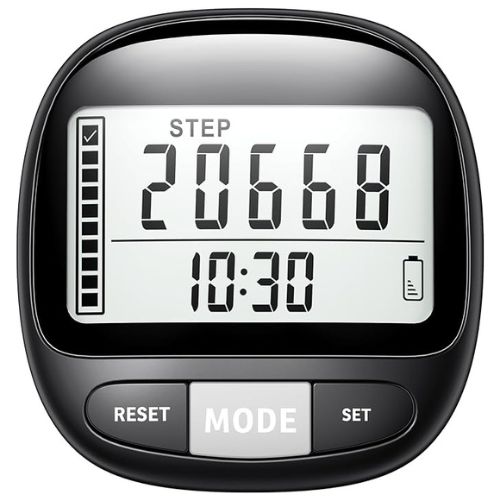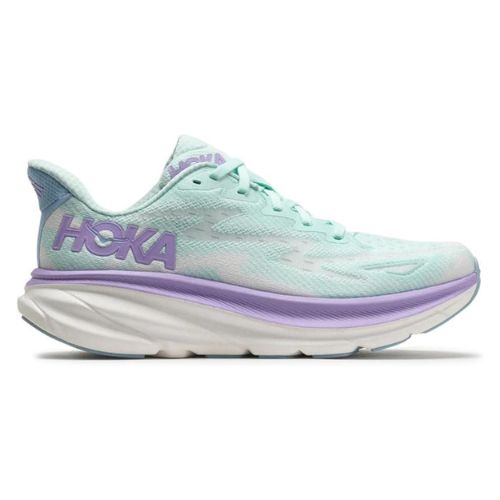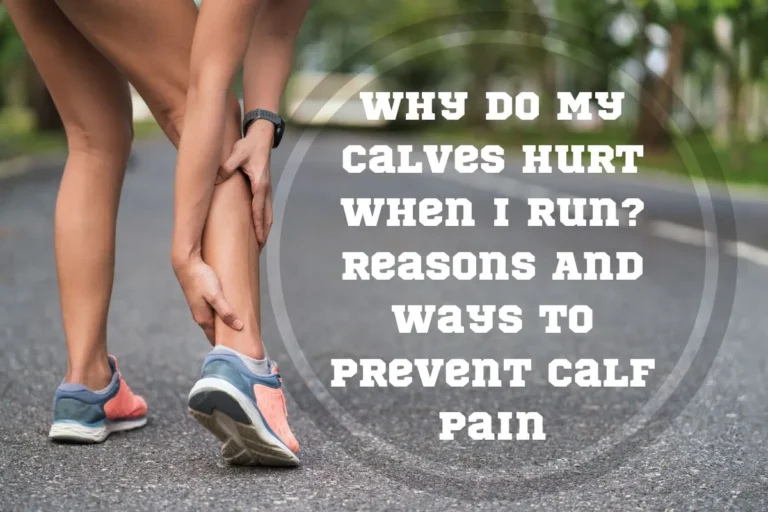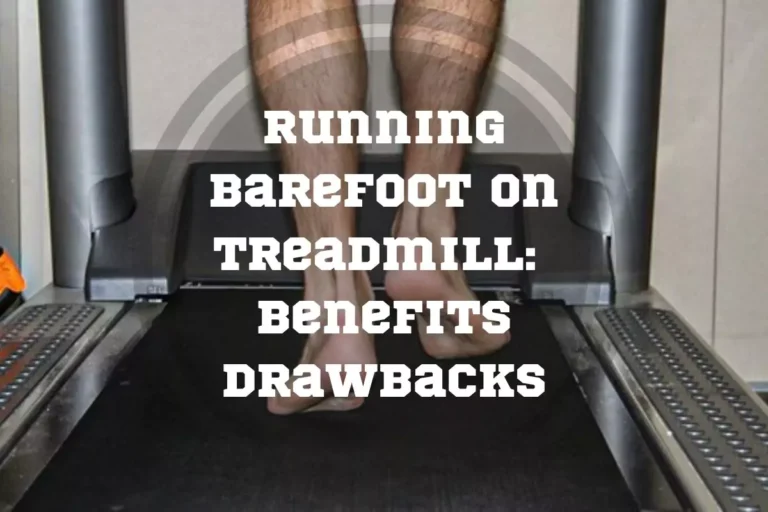17000 Steps To Miles: Converting Step By Step
Seeing your fitness tracker hit that magic 17000 step count is fantastic, but have you ever wondered what distance that is? You know you’ve just made a whole lot of steps, but how far is that? Well, wonder no more because we’re about to see how to convert 17000 steps to miles.
Of course, this is not just about the numbers because you also want to understand how this impacts your daily stride, and if you’re one of those that’s still working their way towards this number, we’ll share some handy tips on how to get there. Be prepared to work for it, though; there are no shortcuts here.
So, grab your walking buddy (a podcast, a furry four-legged family member, your Spotify playlist…) and let’s see what distance you cover when you walk (run, jog, what have you) 17000 steps.
What Do You Get When You Convert 17000 Steps To Miles?
Usually, this amount of steps translates to about 8.5 miles. However, there are things that can influence this, like the length of your stride and it affects the precise measurement.
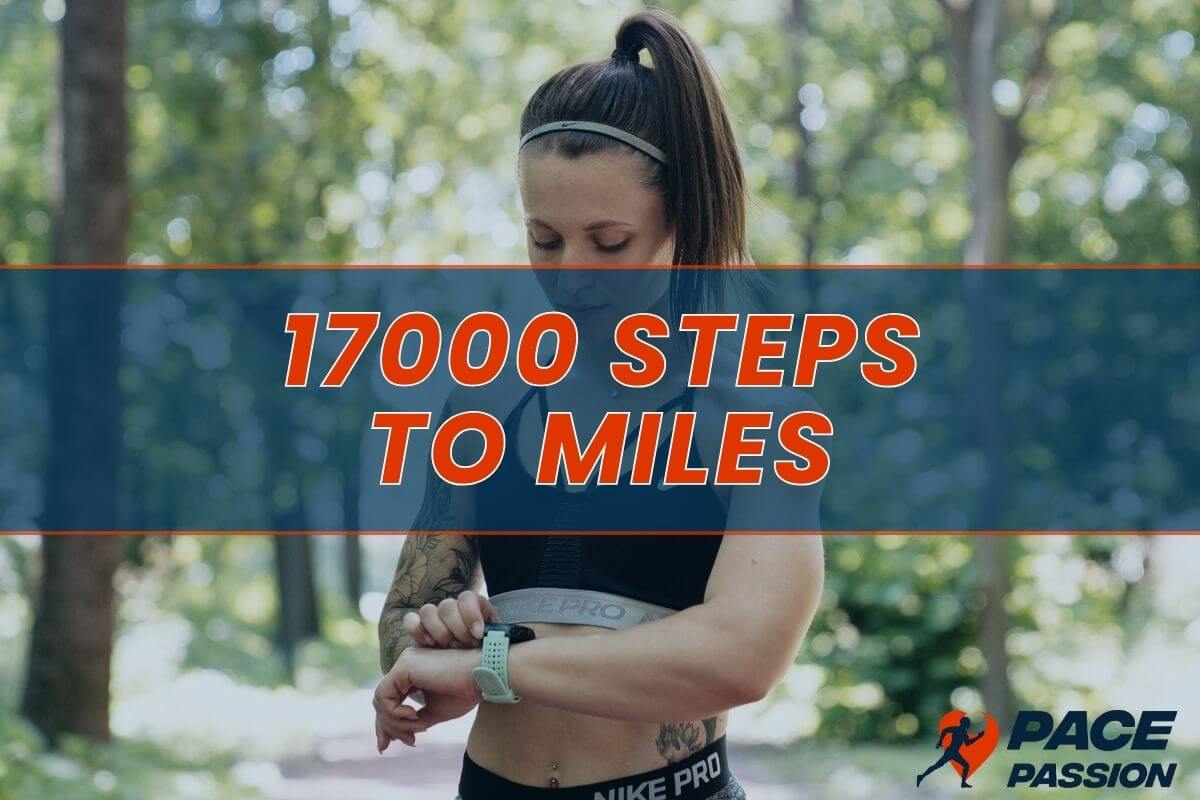
How Many Miles is 17000 Steps?
If we all had the same stride and pace, it would be easy to answer how many miles is 17 000 steps. You could just Google this information and the answer would be one sentence long. But people are not step-counting machines and we all have our own paces and strides; long, short, wonky, etc. Whatever the case, it comes down to the fact that the answer to this question can only be – it depends.
Another thing you need to consider is gender. Men and women cover different distances with the same step count. It sounds kind of bizarre, but it’s true, and that’s partly due to the way we are built. Men generally have longer strides because their stature is usually taller. The height matters, too, because tall people take longer steps, so it influences the distance that is covered.
Speed is yet another player. If you’re taking a leisurely stroll, your steps might not stretch as fast as someone who is power walking or jogging. Think of it like comparing a swift stream to a calm river – same steps, but different flow. On average, though, 17000 steps is around 8 miles (13.6 kilometers) for most people. Keep in mind that this is just the ballpark figure.
| FACTOR | IMPACT ON DISTANCE COVERED |
|---|---|
| Stride Length | Varies from person to person |
| Gender | Men might cover more ground because of their longer strides |
| Height | Taller people take longer steps, which influences distance |
| Speed/Pace | Faster pace results in covering more distance |
How Many Miles is 17k Steps for Running vs Walking?
We’ve established that speed is a major part of how much distance you cover, but you’re most likely also curious about things like how many calories is 17000 steps, what you burn during walking and running, and how either of them challenges your body. Let’s jump right in.

1. 17000 Steps for Running
Running is a fantastic way to burn calories, and although walking will torch some, too, running is better in this aspect because it’s more intense and it engages more muscle groups. On average, a person will burn about 120-130 calories per mile while running, so if you run 17000 steps, you can expect to burn roughly 500-600 calories. If you have a few extra pounds you want to shed, this might be a fantastic way to do that.
The problem with running is, it’s pretty challenging, more so than walking, especially if you’re not used to the impact. If you’re a beginner or if you have issues with your joints, you might find it difficult. If you can, though, try to push through because running is excellent exercise, plus your cardiovascular system will be very grateful to you.
2. 17000 Steps for Walking
Walking 17000 steps takes you on a different kind of journey, and even your mental health will love it. It’s easier to do, that goes without saying, because your strides are shorter, the pace is steadier, and each step is just a gentler motion in general. Usually, you’ll cover less distance with walking than running, but walking has its own set of benefits, and it will still burn some calories.
For 17000 steps, you’ll burn about 400 to 500 calories, which is pretty impressive since it’s a low-impact way to stay active, and that number doesn’t differ that much from running. It’s a lot easier on your joints, so it’s suitable for people of all fitness levels, even those that dedicated their lives to being couch potatoes. You won’t get as many cardiovascular benefits as you would if you were running, so if that’s what you’re mostly after, you might want to choose running over walking.
How Can You Calculate 17k Steps in Miles?
Don’t worry, you don’t need to be very good in math to figure this one out. You can use gadgets to help you make the calculations, but it’s not absolutely necessary.

How to Count the Number of Steps
If you don’t like gadgets or just don’t want to spend money on getting one, you can still do this. The first thing you need to do is to see what is the average length of your stride. Measure the distance you cover in a certain number of steps and then divide that distance by the number of steps you’ve taken. For instance, if you cover 100 feet in 100 steps, your stride length would be 1 foot.
Now you’ll need a little bit of math. Here’s the formula to see what is 17000 steps in miles:
Here, the factor 5280 converts the result from feet to miles.
Remember that stride length differs between walking and running, so if you do both, you’ll need two calculations. This method will give you a rough estimate, but it’s still useful and you’ll get the general idea. If you want something more precise, then you’ll need to invest in something like a pedometer, smartwatch, or a fitness tracker.
Fitness trackers monitor several aspects of your physical activity, including step count. They usually have built-in algorithms that calculate the distance covered based on your steps and the length of your stride. If you want to know which one to choose, there are a lot of really good ones, like Fitbit, Garmin, and Apple Watch.
Pedometers are a lot more simple and all they do is count your steps. They don’t have any of the advanced features fitness trackers do, but they’ll still give you a basic measure of steps and you’ll be able to see which distance you cover.
Smartwatches are a different story and they’re kind of an all-in-one solution. They have a ton of features, and among them are those that can track your steps and help you convert it into distance. These gadgets are a great way to track your information because you can set them up with information about your height and weight, and some advanced models even let you put in the stride length. If you want the most accurate information possible, you’ll need to get some type of gadget, and we have a great one for you – simple to use and super affordable.
Gadget for Counting we Recommend – Itaose 3D Pedometer
Itaose’s pedometer is really simple, but it can do more than just count your steps – it also counts calories, distance, and time.
The display is large and easy to read, and with this pedometer, you don’t need Bluetooth, your phone, or any kind of app connection, so it’s very user-friendly even for the elderly. It has a 7-day memory function that records data over the course of the week and this allows you to analyze your progress.
The 10-step error-proof function makes this pedometer very accurate because it excludes all data not related to exercise, like slight jitter or other non-motion information. It uses 3D 3-axis sensor technology for precise tracking, which is more than what your standard trackers can do. You also have a goal-setting feature that lets you establish daily fitness targets.
The battery is one of its most impressive features because you will need to charge it once every year.
That’s right, you read correctly – only once a year. Don’t you wish your iPhone could be like that?
Pros:
- Very affordable
- Lightweight
- Precise
- Long battery life
Cons:
- Weak clip
- A bit difficult to set up
If you want something affordable, lightweight, and super easy to use, give this pedometer a chance and it will impress you. Logging 17k steps in miles is impressive, and this tracker will show you exactly when you hit that number.
Distance Calculator: Miles In 17000 Steps
Our recommendation is that you can calculate the own distance which you will cover with 17,000 steps. This tool employs a formula that considers the average step length and the runner’s height to determine the distance.
Distance Calculator
Result:
How to Improve Your Performance in Reaching 17,000 Steps for Running
Reaching 17000 steps is impressive, to say the least, and if you’re still struggling to get to that number, we have a few tips to share.
1. Gradual Progression
It doesn’t matter if you’ve decided to cover 17000 steps through running or walking, the only thing that’s important is that you do it slowly – bit by bit. Don’t do any sudden jumps in mileage because that leads to fatigue and injuries. Give your body enough time to adapt and increase the distance on a weekly basis.
2. Consistent Pace
Being consistent is really important if you want to reach higher step counts, so keep your pace steady and sustainable. If you don’t, you’ll burn out too fast. You want a pace that is challenging, but still manageable.
Subscribe to Our Running Newsletter!
Get free running tips from renowned professional athletes and discounts from top-notch brands.
3. Warm Up
Never start your running session without warming up first. Warm-ups are important because they prepare your body for the workout and reduce the risk of injuries.
4. Proper Footwear
Get good quality running shoes that have enough support and cushioning. If you wear good shoes, you’ll be more comfortable, and your running session will be more efficient.
Running Shoes we Recommend – HOKA ONE ONE Clifton 9
The best running shoes Hoka One One 9, which is a brand known for comfortable, quality running shoes that provide great support and shock absorption.
These shoes are designed with a wider fit and have neutral support, so if you have wide feet or like some extra room for your toes, you’ll appreciate the fit. The wider fit may not work for everyone, but it plays a huge part in making larger feet feel fully comfortable.
5. Breathing
When you mention breathing, most people think of relaxation, yoga, or something like that. But breathing is important for running, too, because it delivers oxygen to your muscles, which improves endurance and prevents early fatigue. Pay attention to your breathing rhythm and do deep, controlled breaths.

Pro Tip:
Apart from breathing, pay attention to your form and the rhythm of your steps. It will help you stay engaged and prevent your mind from wandering. If you’re totally focused on your run, your performance will be better and more enjoyable.

Pro Tip:
Apart from breathing, pay attention to your form and the rhythm of your steps. It will help you stay engaged and prevent your mind from wandering. If you’re totally focused on your run, your performance will be better and more enjoyable.
6. Strength Training
Even though your focus is on running, you’ll benefit from strength training because it will make your legs, core, and upper body stronger. This will help make your running mechanics better, so each step you take will be more powerful and efficient.
FAQ
How Many Calories Is 17000 Steps?
That depends on a few things – the length of your stride, pace, weight, and overall fitness level. But on average, you’ll burn around 100 calories per mile if you’re walking, and 120-130 calories per mile if you’re running. That translates to about 400-500 calories if you’re walking 17000 steps, or 500-600 calories if you’re running.
Does Walking 17000 Steps Reduce Belly Fat?
You can’t target fat loss, so no exercise will reduce only your belly fat. To lose fat in your stomach area, you need calorie deficiency that will promote fat loss throughout your entire body. If you walk or run this distance on a regular basis and combine it with a healthy diet, it will result in overall fat loss, which includes your midsection.
Is 17000 Steps A Day Good For Running?
Running 17000 steps daily is pretty intense and it’s more high-intensity training than something in line with daily step recommendation. If you really want to do this daily, it might be best to have a word with your doctor first, just to check that it is okay. Keep in mind that rest days are important, so give yourself at least one day a week to rest and recover.

Conclusion
Step by step, and we’re done! So, how much is 17000 steps? Well, it’s a lot, and that’s the simplest answer anyone can give you. You now have a general idea of how far is 17000 steps and it’s an impressive distance, whether you’re walking or running. Walking is good for everyone, and running will add an extra cardio kick. If you want to measure your steps as accurately as possible, it’s best to get some type of gadget. Some of them will be an investment, but if you go with our recommendation, the Itaose 3D Pedometer, you’ll get a precise pedometer without spending a lot of money on it.
How many steps is your record? Have you ever walked or ran 17000 steps? Do you use a gadget to measure the number of steps you take?
Feel free to leave a comment, question, or suggestion!
Running out!
References:
- Andrea J. Fradkin, Tsharni R. Zazryn, James M. Smoliga “Effects of Warming-Up on Physical Performance: A Systematic Review with Meta-Analysis,” Journal of Strength and Conditioning Research 24, no. 1 (2010): 140-148.
- Becks Shepherd, “Why are Rest Days Important,” LiveScience, https://www.livescience.com/why-are-rest-days-important (accessed March 4th, 2024)
- Katherine Zeratsky, R.D., L.D. “Can I Lose Weight If My Only Exercise Is Walking?” Mayo Clinic, https://www.mayoclinic.org/healthy-lifestyle/weight-loss/expert-answers/walking/faq-20058345 (accessed March 4th, 2024)
- Linda D. Wilkin, Antoinette Cheryl, Bryan L. Haddock “Energy Expenditure Comparison Between Walking and Running in Average Fitness Individuals,” Journal of Strength and Conditioning Research 26, no. 4 (2012): 1039-1044.
- Martin Mau, Anders Aaby, Søren Harnow Klausen, Kirsten Kaya Roessler “Are Long-Distance Walks Therapeutic? A Systematic Scoping Review of the Conceptualization of Long-Distance Walking and Its Relation to Mental Health,” International Journal of Environmental Research and Public Health 18, no. 15 (2021): 7741.
- All photoes are made by our PacePassion Media Team.
If you have any questions or suggestions, you can contact us via email – [email protected]

